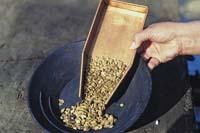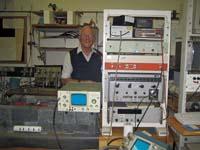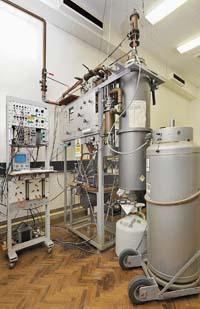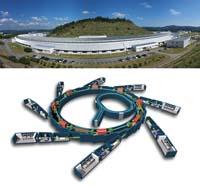In the smallest magnets, the golden ones

They have managed to convert a non-magnetic element into magnetic. However, the discovery goes beyond converting non-magnetic elements into magnetic. In fact, these magnetic characteristics have been found when they are smaller than the smaller particles of traditional magnetic elements. In fact, you can say that they are the smallest magnets that have been gotten. On the other hand, normally these characteristics are given at low temperatures. In this case, they have also observed that they occur at temperatures much higher than the environment.
This work opens the doors to new applications. These magnetic particles can be used both in magnetic memories and in medicine. In medicine they would have two main applications: on the one hand, they would be used as drivers of contrasts in magnetic resonances and, on the other, as transporters of drugs to certain points such as tumors. That is, the drugs would only go to cancer cells, without causing any damage to healthy cells. In fact, current treatments are very aggressive for the body.
Small is 'different'
It is said that the small is 'different', and in the case of gold the same happens. That is, it is not enough to observe the behavior of physical systems at large scales to predict what may occur at levels of few atoms. "The decrease in the size of the elements significantly alter their magnetic characteristics. Magnetic characteristics depend on the electronic structure of the material and changes occur as we approach the nanometric scale," explains José Javier Saiz Garitaonandia, a physicist at the UPV Faculty of Science and Technology.

UPV-EHU and international researchers have discovered that gold nanoparticles are magnetic at room temperature and surrounded by organic molecules. For example, when surrounded by thiol (carbon molecules, hydrogen and sulfur), gold nanoparticles become ferromagnetic, although thiols are diamagnetic like gold atoms.
When gold nanoparticles surround themselves with thiol, sulfur and gold atoms form a covalent bond. In this solid bond there is a small transfer of charge from the gold atom to the sulfur atom, so the last electronic layer of the gold atom does not appear full. This causes a small magnetic moment every time a gold atom binds to a sulfur atom.
A golden particle of one centimeter radius is surrounded by thiol. One of the hundred million atoms on the surface of this particle would be magnetic. In the case of nanoparticles, half of the atoms would be magnetic.
However, some research groups that knew him, such as scientist Antonio Hernando, interviewed in the magazine in November last year, and his team from the Institute of Applied Magnetism in Madrid. But the origin of this surprising behavior was unknown. Often this magnetism is associated with impurities. That is, it is believed that impurities are usually responsible for this magnetism of gold. On this occasion, the team of researchers from the Faculty of Science and Technology of the UPV and the team of Japanese and Australian researchers have learned about the origin of gold magnetism.

For this they have used complex techniques, both in Australia and in Japan, which only analyze the element that is wanted to investigate. They are nuclear techniques and based on particle accelerators.
From Australia to Japan
On the one hand, they used the Mössbauer nuclear technique. Research into the magnetic properties of materials is one of the most common applications of Mössbauer spectroscopy. Only five or six laboratories in the world have this advanced technique, one in Australia, attended by researchers from the UPV. "At the Faculty of Science and Technology we have the Mössbauer spectrometer, but it is optimized for iron and gives problems in the case of gold," explains Saiz Garitaonandia.
Mössbauer is a high-definition technique. The electrical and magnetic interactions in which atomic nuclei intervene are called hyperfine interactions. In Mössbauer spectroscopy it is very easy to observe these interactions. Many of the magnetic compounds can be obtained from these hyperfine parameters.

In Mössbauer's nuclear technology, the radioactive source is usually another element. "We first activated the radioactive source (in this case platinum 197) in a Sydney nuclear reactor. This radioactive source emits neutrons and platinum becomes gold 197. As soon as we got it, we had to catch the plane and pass from Sydney to Melbourne. In fact, the Melbourne spectrometer was prepared to introduce the radioactive source. We work against the clock," explains Saiz Garitaonandia.
This experiment shows how many atoms are magnetic and how many are not. Each atom emits a signal. UPV-EHU researchers found that only atoms on the surface of the particle are magnetic. It is logical. In fact, surface atoms mostly bind to organic molecules, such as thiols.

On the other hand, the technique based on particle accelerators was carried out in the Japanese syncotron Spring 8. It is currently the most energetic syncotron in the world, working at 8 GeV. In a syncotron there are several lines of research. Each line works in a certain energy range. Therefore, it is necessary to know beforehand whether the experiment that everyone wants to investigate can be carried out at any of these energy intervals. "In the case of gold we wanted to study the transition of the 5d electron, and we saw that it was possible in Japan; - Eider Goikolea underlined the chemistry - we adapted all the optics and began to experiment." Nevertheless, UPV researchers observed that the 5d electron of the gold atom was magnetic.
These two techniques have undoubtedly demonstrated for the first time the presence of magnetism in gold atoms, although in any other condition they are not properly magnetic. In addition to gold, this behavior has been found in 2 nm silver and copper nanoparticles.
The contribution of all this work will be incorporated into the doctoral thesis of chemistry Eider Goikolea Nuñez. This thesis is directed by professors Jose Javier Saiz Garitaonandia and Maite Insausti Peña.





